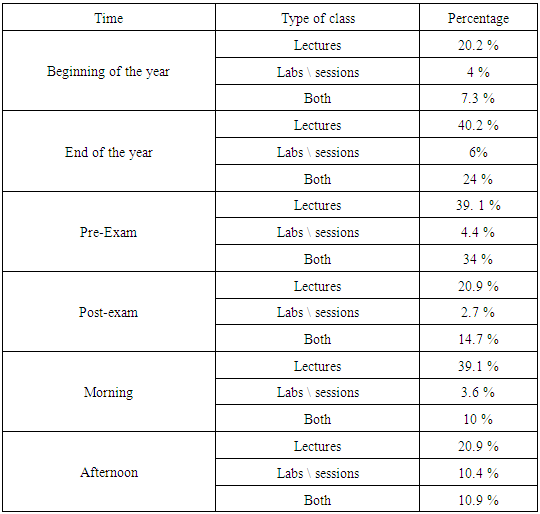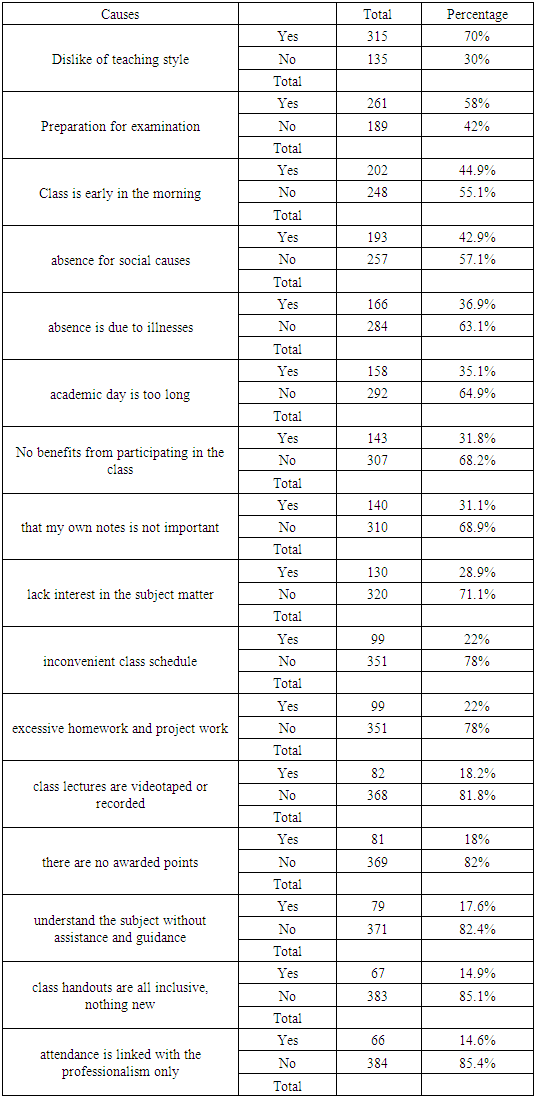-
Paper Information
- Previous Paper
- Paper Submission
-
Journal Information
- About This Journal
- Editorial Board
- Current Issue
- Archive
- Author Guidelines
- Contact Us
Education
p-ISSN: 2162-9463 e-ISSN: 2162-8467
2016; 6(1): 9-12
doi:10.5923/j.edu.20160601.02

Prevalence, Causes and Impacts of Absenteeism among Medical Students at UQU
Ahmed Alghamdi , Ahmed Yamani , Ayman Khalil , Baraa Albarkati , Osama Alrehili , Mohamed Salih
Umm Alqura University, Makkah, KSA
Correspondence to: Baraa Albarkati , Umm Alqura University, Makkah, KSA.
| Email: |  |
Copyright © 2016 Scientific & Academic Publishing. All Rights Reserved.
This work is licensed under the Creative Commons Attribution International License (CC BY).
http://creativecommons.org/licenses/by/4.0/

Introduction: Absenteeism is one of the main concerns in university education worldwide. There are many causes for absenteeism and direct effects, as well, on the students' academic performance. This study is to explore the prevalence, causes and impacts of medical students’ absenteeism at Umm Al-Qura University (UQU). Method: A cross-sectional study using a questionnaire to collect data (online) from medical students (second to sixth year students) of the faculty of medicine at umm alQura university. The researchers developed a structured questionnaire with questions grouped under themes related to absenteeism such as reasons and patterns of absenteeism. The data was analyzed and the results were obtained using (SPSS) version 20. Results: There were 136 students (30.2%) with less than 5% missed hours of the total class hours, and 7 students (1.6%) with more than 25% missed hours. The mean of rate-missed hours is (5-10%). The higher rate of missed hours was seen in married and those who have a part time job students. The causes of absenteeism ranged from dislike of teaching style 315 (70%) to many others including social ones 193 (42.9%). Conclusions: In general, the overall percentage of absenteeism is comparable to that of the studies carried out in and in nearby countries. The study showed the performance GPA mean is influenced by non-attendance.
Keywords: Absenteeism, Rate-Missed hours, GPA
Cite this paper: Ahmed Alghamdi , Ahmed Yamani , Ayman Khalil , Baraa Albarkati , Osama Alrehili , Mohamed Salih , Prevalence, Causes and Impacts of Absenteeism among Medical Students at UQU, Education, Vol. 6 No. 1, 2016, pp. 9-12. doi: 10.5923/j.edu.20160601.02.
1. Introduction
- The faculty of Medicine at Umm Al-Qura University endeavors to graduate high caliber physicians with adequate medical knowledge and high clinical skills [1]. High attendance is crucial for the learning process of both; the basic and clinical science courses in order to best perform in the overall score and clinical career as well [2]. Some have pointed out positive correlation and relationship between academic performance and attendance [4]. However, some have shown a negative relationship between student absenteeism and their academic performance [5]. Absenteeism has been shown to be an indicator of low level of motivation for learning [6].Studies have named some causes for increasing absenteeism, such as: lower subject interest, poor and boring teaching technique, unfavorable environment, extreme student socialization, commitment to part-time jobs, insomnia and ill health, poor relationships with teachers [7], [8], [9], [12]. Others have identified availability of lectures, online slides, videos or audio recordings as causes of absenteeism. [10-11]. One study showed over-sleeping as the primary cause of student absenteeism [10].Absenteeism affects the learning-teaching process and disturbs the well-being of the class [13]. In quality terms, absenteeism is a waste of educational resources, time and human potential. Student absenteeism also causes rework and wasted time for lecturers [14]. This study explores the absenteeism and its impacts at the faculty of Medicine in Umm Al-Qura University among (2nd to 6th year) medical students during the academic year 2014-2015. To our knowledge, there have been no previous studies which examined the phenomenon of absenteeism and its impacts and association with the academic performance of the students at the faculty of Medicine in Umm Al-Qura University.
2. Methodology
- This study is a descriptive cross-sectional one, which was conducted during the academic year 2014/2015, among the 2nd to 6th year students of the faculty of Medicine, in Umm Al-Qura University, Mecca, Saudi Arabia. A structured questionnaire was developed with the questions grouped into themes of: patterns of absenteeism, reasons for absenteeism and activities during absence from classes. To ensure confidentiality, personal information was not included in the questionnaire. 450 male and female students responded and agreed to enroll in the study. Ethical approval was obtained from the committee of BIO-MEICAL ethics in UQU. Data was statistically analyzed and interpreted using Statistical Package for Social Sciences (SPSS) version 20. Descriptive statistics which include (mean, standard deviation and proportion) were used in order to summarize the different variables (quantitative and qualitative). Frequency and Descriptive statistics (Range, mean, minimum, maximum, sum and standard deviation) were also used. The individual Student’s t-test and one-way analysis of variance (ANOVA) were used for comparing the different values of the mean of the continuous variables at the 2nd and 3rd levels of categorical variables.
3. Results
- 450 students, among which 270 males (60%) and 180 females (40%), responded and completed the questionnaire. The total sample, 450, was represented as 2nd year (65 students) 14.4%, 3rd year (97) 21.6%, 4th year (96 students) 21.3%, 5th year (73 students) 16.2% and 6th year (119 students) 26.4%.There were 136 students (30.2%) with less than 5% missed hours of the total class hours, 96 students (21.3%) with 5-10% missed hours, 87 students (19.3%) with 11-15% missed hours, 96 students (15.3%) with 16-20% missed hours, 55 students (12.2%) with 21-25% missed hours, and 7 students (1.6%) with more than 25% missed hours. The mean of rate-missed hours is (5-10%).In the analysis, there was no relation between students gender, current residency, suffering from a disease, interested in studying medicine, time of journey to university, type of transportation, daily activity and the daily sleep hours and the absenteeism.On the other hand, the mean of rate-missed hours among single students is (5-10%), while married and engaged students is (11-15%) respectively. This has revealed the marital status effects on absenteeism. Also there was an association between GPA and the rate of missed hours through the mean of rate-missed hours. Students who have different GPA have same mean of rate-missed hours (5-10%) except students who have D grade in GPA have higher rate-missed hours (11-15%).The mean of rate-missed hours in students who have part time jobs is (11-15%).Also students who have a study time less than 1 hour/day have high rate-missed hours is (11-15%), while students who study for 1-2 hours/day, students who study for 3-4 hours/day and students who study for more than 4 hours/day have the same mean rate-missed hours (5-10%).The highest percentage of absenteeism, by the time, was in pre-exams 77.6% and end of the year 70.2%, indicating that students were concentration more on studying hard preparing for exams rather than attending the lectures, labs and other sessions. (Table 1- The largest number of respondents is due to the possibility of choosing more than one choice)
|
|
4. Discussion
- In this study, the rate of hours missed is (5-10%), majority of student absenteeism at pre-exam period (78.6%), other studies showed similar students attitude [2, 21]. The major causes for absenteeism as reported by participants were unfavorable teaching strategies, preparation for examinations, early-morning classes and social causes which is consistent with previous studies [21]. Unfavorable teaching strategies were the main cause for absenteeism. Student absenteeism was significantly associated with marital status and part-time job. The married students and those who have part time jobs are more susceptible to absence due to non-academic workloads. In this study, the students had dissimilar modalities of academic year absenteeism. The majority of participants mentioned that their absence is in the pre-exams period and at the end of the year, this is may be due to lack of preparedness, so the students prefer to spend time on study rather than attending lectures. According to our study, the absence in the morning lectures is higher than absence in the afternoon lectures that can be due to delay going to bed. The intensive study before the exams contributes significantly to the high percentage of absence in the pre-exams period. We think the application of strict attendance policy is a main factor that influence student attendance as showed be some studies [22-23].Our study showed no significant correlation between student absenteeism and performance, as showed by many previous studies [5], online availability of lectures as written, recorded or videotaped in association with no signed marks for attendance can explain the presence of the absenteeism phenomenon. The overall percentage of absenteeism is comparable to that of the studies carried out in and in nearby countries [2, 21].
5. Conclusions
- In general, the overall percentage of absenteeism is compa rable to that of the studies carried out in and in nearby countries. The study showed the performance GPA mean is influenced by non-attendance. The major causes for absen teeism were unfavorable teaching strategies, preparation for examinations, early-morning classes and social causes like marriage and part time job. We recommend working on the causes of absenteeism to further increase the rate of attend ance of all academic activities.
ACKNOWLEDGEMENTS
- The authors would like to acknowledge the help of Atheer alshrif, Anas Almymani, Hamed Sufyani and Bilal Felmban.
 Abstract
Abstract Reference
Reference Full-Text PDF
Full-Text PDF Full-text HTML
Full-text HTML
